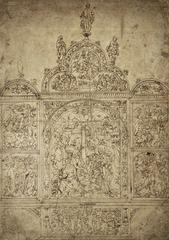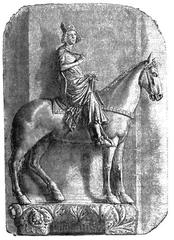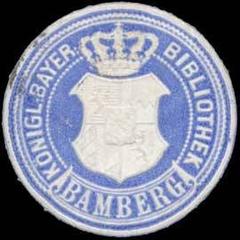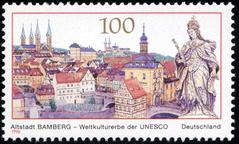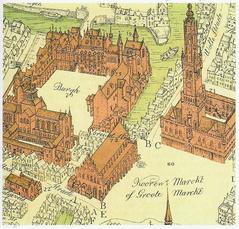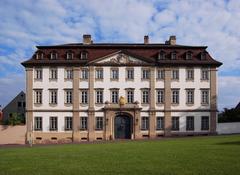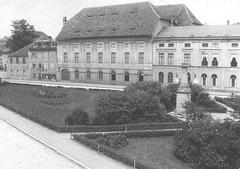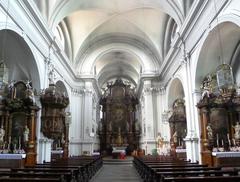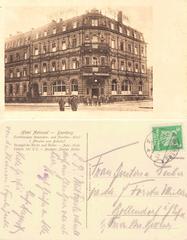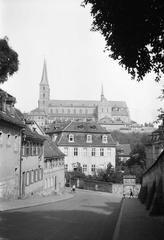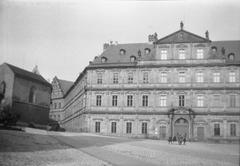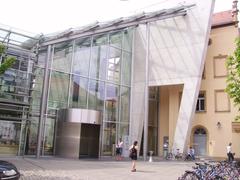Wohnhaus Bamberg: Visiting Hours, Tickets, and Historical Significance Guide
Date: 14/06/2025
Introduction
Located in the heart of Bamberg’s UNESCO World Heritage-listed Old Town, the Wohnhaus district offers an exceptional journey into Germany’s medieval and baroque past. These historic residential houses, or “Wohnhäuser,” are not just architectural gems but living symbols of Bamberg’s enduring cultural, economic, and ecclesiastical identity. Unlike a single monument, Wohnhaus refers to a network of historic homes, many dating from the 14th to 18th centuries, that line the city’s winding, cobblestone streets. Their half-timbered façades, baroque stucco details, and stone masonry narrate the evolution of Bamberg from a princely seat to a thriving trade and religious center (UNESCO, Germany Travel).
This guide provides comprehensive, practical information about Wohnhaus Bamberg visiting hours, tickets, accessibility, and visitor recommendations. You’ll also find insights into architectural highlights, local experiences, accommodation, dining, and responsible tourism to help you plan a memorable visit to this remarkable district.
Historical Context of Wohnhaus in Bamberg
Urban Evolution and Social Fabric
Bamberg’s development as a city took off in the 10th century under Emperor Heinrich II, shaping an urban plan that still defines the Old Town today. Wohnhäuser were designed to meet the needs of both the ruling elite and a growing merchant class. Their placement on Bamberg’s famous seven hills and within its narrow lanes illustrates the organic growth of a city balancing market activity, residential life, and religious authority (UNESCO).
Socio-Economic and Ecclesiastical Significance
Wohnhäuser were often multifunctional—merchants, craftsmen, and minor nobility lived above their workshops or stores, integrating economic and domestic life. As Bamberg was a powerful prince-bishopric until 1802, ecclesiastical regulations shaped the city’s built environment, ensuring architectural harmony and the close interplay between secular and sacred spaces (Joey is a Traveler, Explorial).
Architectural Significance
Distinctive Features
- Half-Timbered Construction (Fachwerk): Characteristic exposed wooden beams and infill panels, denoting the status and wealth of historical owners (Discover Walks).
- Baroque and Rococo Elements: Stucco facades, grand staircases, and decorative motifs reflecting Bamberg’s prosperity under the prince-bishops (UNESCO).
- Stone and Brick Masonry: Durable materials used especially in larger townhouses, contributing to the longevity and fire resistance of these structures.
Integration and Preservation
Wohnhäuser are seamlessly woven into the medieval street plan, with little or no setback from the street and a high degree of urban intimacy. The preservation of over 2,400 listed buildings in Bamberg, including many Wohnhäuser, is central to the city’s UNESCO status (UNESCO). Restoration efforts often extend to authentic interiors and period furnishings.
Notable Examples
- Obere Sandstraße and Karolinenstraße: Streets with excellent examples of preserved half-timbered houses.
- Domplatz Area: Residential buildings juxtaposed with monumental ecclesiastical architecture (Explorial).
Visitor Information: Wohnhaus Bamberg Visiting Hours, Tickets, and Tours
Hours and Accessibility
- Wohnhaus District: Open to the public at all times; no entrance fees or restrictions for exploring the residential streets.
- Museums and Cultural Venues: Typically open 9:00 AM–5:00 PM, with some seasonal variation. Always check official sites or the Bamberg Tourist Information Centre for up-to-date details.
- Accessibility: Due to the historic street layout, some areas may be challenging for visitors with disabilities. However, efforts have been made to improve access at several public venues (Bamberg Info).
Tickets and Guided Tours
- Entry Fees: Museums and special exhibitions in historic Wohnhäuser charge €5–€10 for adults, with discounts for students and groups.
- BAMBERGcard: Highly recommended for visitors, this three-day pass includes access to major museums, guided city tours or audio guides, and unlimited bus travel (Bamberg Info).
- Guided Tours: Available in multiple languages, focusing on architectural, historical, or thematic aspects of the Wohnhaus district. Advance booking is advised during high season.
Special Events
Wohnhaus courtyards and squares often host cultural events, such as open-air concerts, traditional markets, and seasonal festivals, providing unique opportunities to experience Bamberg’s local traditions (Bamberg Veranstaltungskalender).
The Wohnhaus Visitor Experience
Architectural and Cultural Exploration
Take a walking tour to discover the variety of architectural styles—half-timbered, baroque, and rococo—while enjoying the convivial atmosphere of Bamberg’s residential quarters. Museums like the Gärtner- und Häckermuseum and cultural venues in restored Wohnhäuser provide insight into daily life across centuries (Urban Meanderer).
Living Culture
The Wohnhaus district is alive with bakeries, artisan shops, cafés, and traditional Franconian restaurants. This is where locals gather, offering visitors an authentic window into Bamberg’s everyday rhythms. Try specialties like Rauchbier (smoked beer) or Schäufele at a historic brewery, and pause to appreciate the quiet beauty of hidden courtyards.
Proximity to Attractions
Wohnhaus is ideally situated for easy exploration of Bamberg’s top sights:
- Bamberg Cathedral: A Romanesque masterpiece with imperial tombs.
- New Residence and Rose Garden: Stunning views and over 4,500 rose bushes (1xMarketing).
- Altes Rathaus: The iconic Old Town Hall on a bridge over the Regnitz.
Accommodation and Dining Near Wohnhaus
Where to Stay
- Luxury: Welcome Hotel Residenzschloss Bamberg, Villa Geyerswörth (The Hotel Guru).
- Mid-range: Hotel Nepomuk, Altstadthotel Messerschmitt (Booking.com).
- Budget: Backpackers Bamberg – Little Venice, Ibis Budget Bamberg.
- Apartments/B&Bs: Aparthotel Gartenstadt, Tandem Hotel (Penguin and Pia).
Where to Eat
- Traditional: Schlenkerla (famous for Rauchbier), Zum Sternla (Nomadic Samuel).
- Modern/International: Restaurant Eckerts, Villa Geyerswörth Restaurant.
- Cafés: Café Abseits, Pelikan.
- Beer Gardens: Numerous options for sampling Bamberg’s beer heritage.
Accessibility and Practical Tips
- Getting There: Trains to Bamberg from Nuremberg and Munich are frequent. The Old Town is a 15-minute walk from the main station (Booking.com).
- Getting Around: The Wohnhaus area is best explored on foot. The BAMBERGcard includes public transport. Some streets are steep and cobbled; wear sturdy shoes.
- For Disabled Visitors: Some historic buildings have limited wheelchair access; inquire with venues or the tourist office for accessible routes.
Sustainable and Responsible Tourism
- Respect Heritage: Do not touch delicate surfaces or disturb residents.
- Support Locals: Choose independent shops and restaurants, and consider joining guided tours.
- Travel Green: Walk or use public transport to minimize your environmental impact.
- Cultural Sensitivity: Observe local customs and quiet hours after 10 p.m.
Frequently Asked Questions (FAQs)
Q: What are Wohnhaus Bamberg visiting hours?
A: The Wohnhaus district is always open; museums typically open 9:00 AM–5:00 PM, closed Mondays and holidays.
Q: Are tickets required?
A: The district is free to explore; tickets are needed for museums and some guided tours.
Q: Is Wohnhaus wheelchair accessible?
A: Accessibility varies due to historic layouts; check with venues and the tourist office for details.
Q: Are guided tours available?
A: Yes, in multiple languages, often included with the BAMBERGcard.
Visitor Recommendations
Maximize your experience by combining Wohnhaus exploration with major attractions like Bamberg Cathedral and the Rose Garden. Use the BAMBERGcard for convenience, stay in a historic guesthouse for immersive ambiance, and sample Bamberg’s culinary delights. Always check opening hours and book accommodations early, especially during festival periods. For audio-guided tours and real-time updates, download the Audiala app.
Sources
- UNESCO World Heritage Site - Bamberg, 1993
- Exploring Bamberg’s Wohnhäuser: Visiting Hours, Tickets, and Historical Significance of Bamberg’s Iconic Residential Houses, 2024
- Joey is a Traveler, The Ultimate Travel Guide to Bamberg, 2024
- Explorial, Bamberg Domplatz and Surroundings, 2024
- Germany Travel, Bamberg Sights, 2024
- Bamberg Info, Tourist Information and BAMBERGcard, 2024
- Nomadic Samuel, Bamberg Travel Guide, 2024
- 1xMarketing, Bamberg Rose Garden and Attractions, 2024
- Germany Footsteps, Things to Do in Bamberg, 2024
- Urban Meanderer, Bamberg Insider Tipps
- Penguin and Pia, Where to Stay in Bamberg
- The Hotel Guru, Best Hotels in Bamberg
- Booking.com, Hotels near Bamberg
- Germany Destinations, Bamberg
- Trip.com, Bamberg Itinerary
- Bamberg Veranstaltungskalender (Event Calendar)

